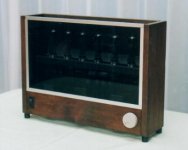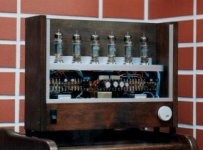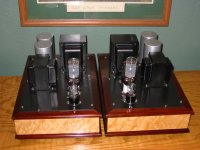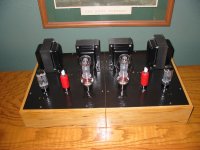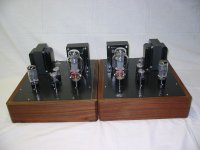What is the tube to the right(left) of the 6C33?
I thought to ask that same question, but then changed my mind. I have too many unconnected thoughts in my head already. Which reminds me that I have some 6C33's stashed somewhere. Ive never lit them up.
Jeb had those monoblocks at BAF 2009 last week, although we never got to hear them upstairs. They sure look nice, though, maybe next year......
I'm sure he will chime in, but IIRC, they have custom PS and OT Edcor iron (600 ohm OT's) and a 5u8 russian rectifier tube operating at relatively low voltages/high current, something like 250V/250 ma per monoblock putting out around 16w/ch.
I'm sure he will chime in, but IIRC, they have custom PS and OT Edcor iron (600 ohm OT's) and a 5u8 russian rectifier tube operating at relatively low voltages/high current, something like 250V/250 ma per monoblock putting out around 16w/ch.
Hello Kevin,
The other large tube is a rectifier. The printing on the glass says "5U8C", but I believe 5C8S is the correct translation.
The small tube is 6F1P (6bl8/ECF80). The pentode section is the input/gain stage, adjustable regulated screen, un-bypassed cathode resistor. The triode section is a cathode follower which is direct coupled to the first stage. The output stage is a self biased common-cathode. As boywonder stated, opperating point is ~ 250V/250ma. All iron is custom edcor, the OPT is 600R.
I would post a schematic, but I'm still tweaking with it regularly. Been toying with several different feedback schemes (including zero feedback) and harmonic distortion cancellation by adjusting the input pentodes screen voltage.
The other large tube is a rectifier. The printing on the glass says "5U8C", but I believe 5C8S is the correct translation.
The small tube is 6F1P (6bl8/ECF80). The pentode section is the input/gain stage, adjustable regulated screen, un-bypassed cathode resistor. The triode section is a cathode follower which is direct coupled to the first stage. The output stage is a self biased common-cathode. As boywonder stated, opperating point is ~ 250V/250ma. All iron is custom edcor, the OPT is 600R.
I would post a schematic, but I'm still tweaking with it regularly. Been toying with several different feedback schemes (including zero feedback) and harmonic distortion cancellation by adjusting the input pentodes screen voltage.
Last edited:
How about aesthetics like this for the valves
Attachments
I don't believe AESTHETICS can be tacked on. Good aesthetics is derived from something being well designed from the inside out and the outside in and placed in an appropriate setting. Of all the components I've seen, I like the QUAD 22 preamplifier and it's accompaning power amplifiers. This has good aesthetics IMHO. The rounded corners, the tactile presentation of the knobs in relief, the edges only partially exposed. The power amplifiers are mono block, thin and long, the power transformer is far away from the input stage. The Marantz II power amp is well designed as well as the model IX. The Nagra 4S reel to reel recorder has good aesthetics as well as the Studer J37. The most famous house in the world; Villa Savoy by Le Corbusier had excellent aesthetics but remained unoccupied and was used to store hay in by a farmer for most of it's existence until an architecture restoration society bought it and placed it in a national trust. But I don't think any of these things will appeal to a WIFE! Ray
opperating point is ~ 250V/250ma.
My mistake for not clarifying, B+ is 255V, but the quiescent plate voltage is ~190V. The bias resistor takes the extra 65V.
Of all the components I've seen, I like the QUAD 22 preamplifier and it's accompaning power amplifiers. This has good aesthetics IMHO. The rounded corners, the tactile presentation of the knobs in relief, the edges only partially exposed. The power amplifiers are mono block, thin and long, the power transformer is far away from the input stage. The Marantz II power amp is well designed as well as the model IX. The Nagra 4S reel to reel recorder has good aesthetics as well as the Studer J37.
I like what you like.
Unlike the architects posting earlier, I´m a Industrial designer and academic in design. Form should obviously function but FORM FOLLOWS FUN.
Therefore I present to you: ELECTROLUV
Now that's design! and if it doesn't pass WAF build an extension to the house.
Therefore I present to you: ELECTROLUV
Now that's design! and if it doesn't pass WAF build an extension to the house.
Therefore I present to you: ELECTROLUV
Now we're talkin'!!......I was wondering when an industrial designer would wander over here....
Those turntables, preamps and tube amps are museum pieces!
Very, very cool IMHO.
Last edited:
"...Now that's design! and if it doesn't pass WAF build an extension to the house."
Keep the house as is, place de gear, escort da wife out the front door...🙂
Keep the house as is, place de gear, escort da wife out the front door...🙂
Last edited:
whoa! I'm in electro-love! Its like the bastard love children of matings between my hi-fi gear and my espresso machine (or in some cases a stationary steam engine). Artdecovintagetechdramasciencefiction on speed!!! Now THAT'S an aesthetic to get divorced for.
Here are some examples of what worked, what didn’t, and what I would do different next time.
Amp1:
This was my 2nd best looking amp. Doing it over I would use 10ga Alum for the top plate, the 18ga steel looks cheap.
Amp2:
Didn’t like this one from day one. Wrong proportions. No more hum pots exposed like that. No input cables on the top of the amp (that’s if the aesthetics win over engineering!)
Amp3:
Crash and Burn on this one..what more can I say!
Amp3_Rev2:
Better, but still didn’t like, Wrong proportions, didn’t like the tube layout, too much lumber exposed on the top of the amp.
Amp4:
(see post#44) My best looking amp so far… doing it over I would make a little deeper and get rid of the big oil caps (again, if the aesthetics win over engineering!)
To summarize:
Use Alum for the top plate… You can make holes with greenlee punches, it’s just the right thickness to mount octal sockets underneath and counter sink the screw holes.
Try for a 1:1.6 ratio for the size of the amp
No screws in the top plate other than the ones that mount the sockets or the iron on top on the amp
Pay attention to the tube and iron layout, including from the height prospective
From now on I do full size prototypes with scrap lumber and the tubes before I start to build the real thing.
Amp1:
This was my 2nd best looking amp. Doing it over I would use 10ga Alum for the top plate, the 18ga steel looks cheap.
Amp2:
Didn’t like this one from day one. Wrong proportions. No more hum pots exposed like that. No input cables on the top of the amp (that’s if the aesthetics win over engineering!)
Amp3:
Crash and Burn on this one..what more can I say!
Amp3_Rev2:
Better, but still didn’t like, Wrong proportions, didn’t like the tube layout, too much lumber exposed on the top of the amp.
Amp4:
(see post#44) My best looking amp so far… doing it over I would make a little deeper and get rid of the big oil caps (again, if the aesthetics win over engineering!)
To summarize:
Use Alum for the top plate… You can make holes with greenlee punches, it’s just the right thickness to mount octal sockets underneath and counter sink the screw holes.
Try for a 1:1.6 ratio for the size of the amp
No screws in the top plate other than the ones that mount the sockets or the iron on top on the amp
Pay attention to the tube and iron layout, including from the height prospective
From now on I do full size prototypes with scrap lumber and the tubes before I start to build the real thing.
Attachments
Stockdam:
Electrolytic caps that stick through the chassis with white on black lettering looks unsightly from the front.. why not turn them round 180°. Aren't the o/p tubes a bit close to the electrolytics ?
Electrolytic caps that stick through the chassis with white on black lettering looks unsightly from the front.. why not turn them round 180°. Aren't the o/p tubes a bit close to the electrolytics ?
Unlike the architects posting earlier, I´m a Industrial designer and academic in design. Form should obviously function but FORM FOLLOWS FUN.
Therefore I present to you: ELECTROLUV
Now that's design! and if it doesn't pass WAF build an extension to the house.
Those have all the tube bling; magic eye tubes, mercury vapor rectifier, what more could one ask for?

Now we're talkin'!!......I was wondering when an industrial designer would wander over here....
Those turntables, preamps and tube amps are museum pieces!
Very, very cool IMHO.
I just find it hard to understand, why they don't make it at a respectable level of craftsmanship. Bad surface finish, and general bad finish. That's kinda sad, considering the effort put in.
Magura 🙂
I showed Electroluv to my wife, an interior designer, no less and she loved them.
People! we´ve been barking up the wrong tree!
People! we´ve been barking up the wrong tree!
Have you heard of Steampunk?
Now there is a bit of form follows fun:
Steampunk Vacuum Tube Guitar Amp | The Steampunk Workshop
http://www.dself.dsl.pipex.com/MUSEUM/COMMS/auxetophone/gaumont1b.jpg
and finaly: ok its not tubes, but they glow and look cool loafing under gaslight: incredible steampunk lamps on [technabob]
Now there is a bit of form follows fun:
Steampunk Vacuum Tube Guitar Amp | The Steampunk Workshop
http://www.dself.dsl.pipex.com/MUSEUM/COMMS/auxetophone/gaumont1b.jpg
and finaly: ok its not tubes, but they glow and look cool loafing under gaslight: incredible steampunk lamps on [technabob]
- Status
- Not open for further replies.
- Home
- Amplifiers
- Tubes / Valves
- Aesthetics
